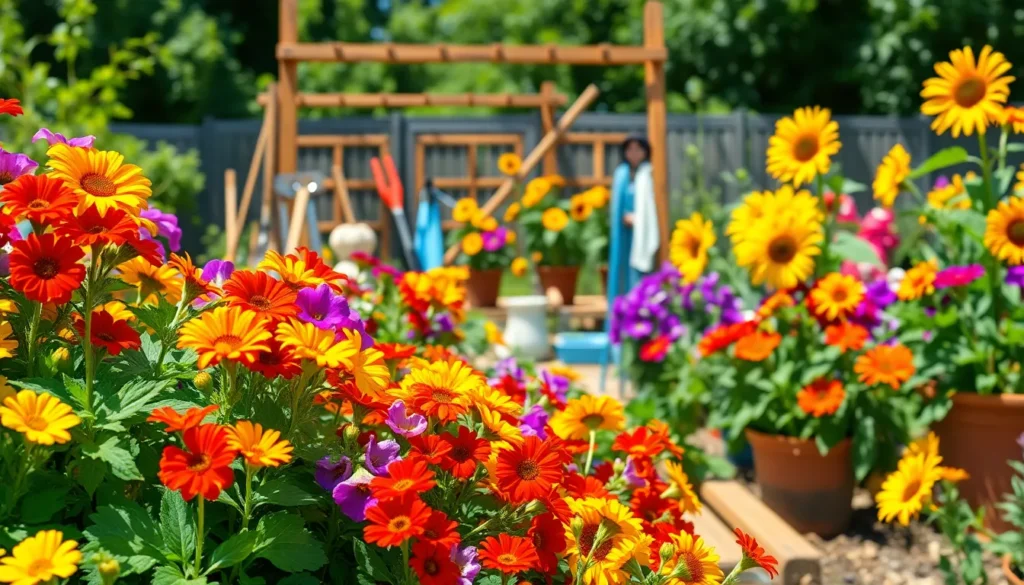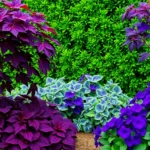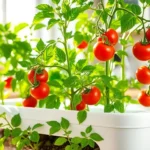Growing edible flowers transforms any garden into a culinary paradise while adding stunning visual appeal to your outdoor space. We’ve discovered that these beautiful blooms don’t just look amazing – they pack incredible flavors that’ll elevate your cooking and impress dinner guests like nothing else can.
From peppery nasturtiums that add zing to salads to delicate violas with their subtle sweetness, edible flowers offer endless possibilities for creative home cooks. We’re talking about plants that serve double duty: gorgeous garden displays that also become gourmet ingredients for your kitchen.
The best part? Most edible flowers are surprisingly easy to grow, even for beginners. We’ll show you exactly which varieties thrive in different climates and how to cultivate them successfully. Whether you’re working with a sprawling backyard or just a few containers on your balcony, you can create your own edible flower garden that’ll have neighbors asking for your secret.
Nasturtiums: The Peppery Garden Favorite
These vibrant, trumpet-shaped flowers add both stunning color and zesty flavor to our gardens and plates. We’ll explore how these versatile blooms can transform your growing space into a productive culinary garden.
Growing Requirements and Care Tips
Nasturtiums thrive in poor to moderately fertile soil with excellent drainage. We recommend avoiding rich soil since this encourages excessive leaf growth at the expense of flower production. These hardy annuals prefer full sun to partial shade conditions.
Planting directly in the garden works best for nasturtiums since they don’t transplant well. We sow seeds 1/2 inch deep after the last frost date in spring. Seeds typically germinate within 7 to 10 days when soil temperatures reach 65°F.
Watering should be moderate and consistent throughout the growing season. We allow soil to dry slightly between waterings to prevent root rot. Overwatering often leads to lush foliage but fewer blooms.
Deadheading spent flowers encourages continuous blooming from summer through fall. We pinch off faded blooms weekly to promote new flower production. Regular harvesting also serves this purpose while providing fresh ingredients for cooking.
Culinary Uses and Flavor Profile
Nasturtium flowers deliver a distinctive peppery bite similar to watercress or arugula. We describe the flavor as slightly spicy with subtle floral notes that intensify as the season progresses. Young leaves offer the mildest taste while mature flowers pack the most punch.
Fresh flowers make excellent salad garnishes that add both color and flavor contrast. We scatter whole blooms over mixed greens or use individual petals for delicate presentation. The flowers pair particularly well with soft cheeses and mild vinaigrettes.
Stuffing nasturtium flowers creates elegant appetizers for special occasions. We fill the trumpet shaped blooms with cream cheese, goat cheese, or herb butter mixtures. These stuffed flowers make impressive additions to party platters.
Nasturtium leaves work wonderfully in sandwiches as watercress substitutes. We layer young leaves in tea sandwiches or use them to add peppery notes to wraps and paninis.
Harvesting and Storage Methods
Morning harvesting yields the freshest nasturtium flowers when blooms are fully open and petals feel crisp. We collect flowers after the dew evaporates but before afternoon heat sets in. This timing ensures maximum flavor intensity and longest storage life.
Gentle handling prevents bruising during the harvesting process. We use small scissors to cut stems about 1 inch below the flower head. Placing blooms immediately in cool water helps maintain freshness.
Fresh nasturtiums last 3 to 5 days when stored properly in the refrigerator. We arrange flowers on damp paper towels inside sealed containers to maintain humidity. Checking daily and removing any wilted blooms prevents spoilage of the entire batch.
Freezing nasturtium flowers in ice cubes preserves them for drinks and decorative purposes. We place individual blooms in ice cube trays with water for colorful additions to summer beverages. These frozen flowers maintain their appearance for several months.
Violas and Pansies: Sweet and Colorful Additions
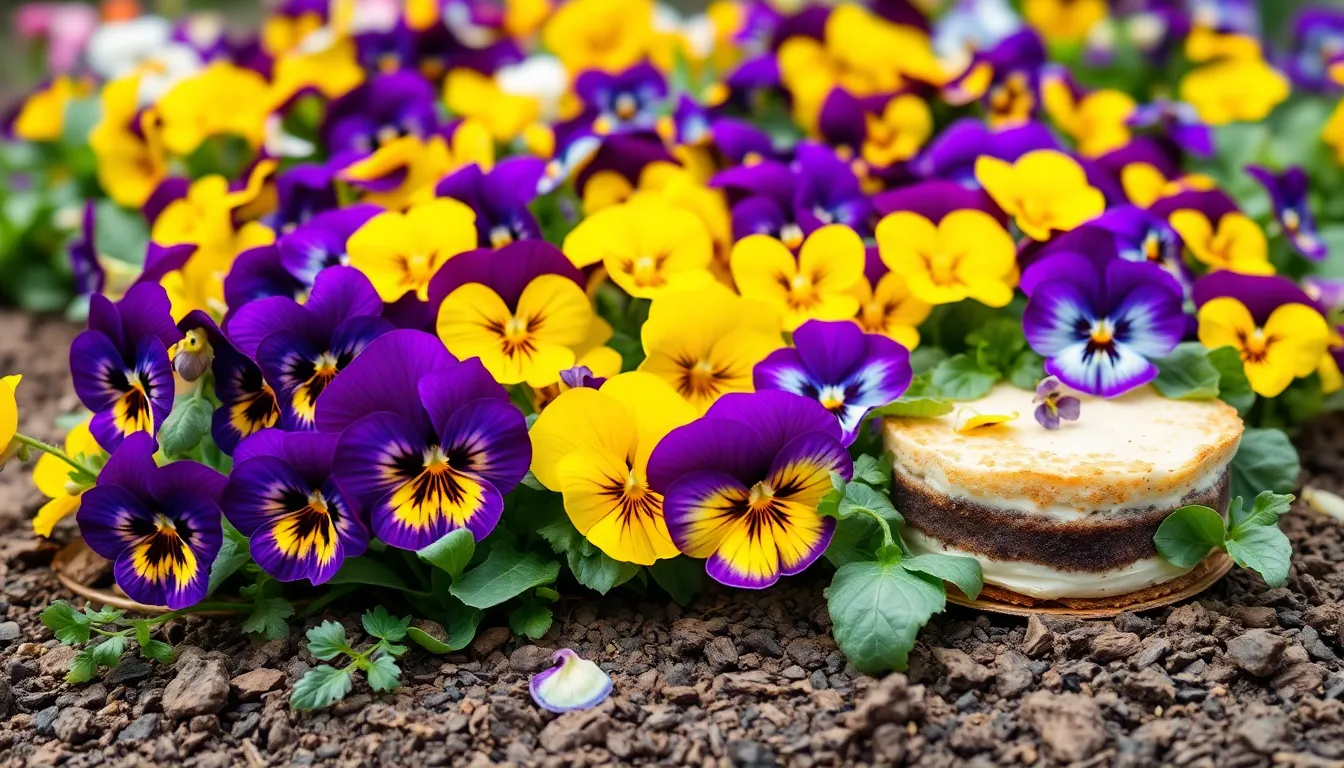
Unlike the bold, peppery nasturtiums we explored earlier, violas and pansies bring delicate sweetness to our edible flower garden. These charming flowers offer vibrant colors ranging from deep purples to bright yellows, making them perfect for both visual appeal and culinary enhancement.
Planting Guidelines for Cool Weather
Violas and pansies thrive in cooler temperatures between 40°F to 70°F, making them ideal spring and fall additions to our garden. We’ll want to plant them in humusy, moist soil with a slightly acidic pH, using peat moss to amend the soil for optimal growing conditions.
Spacing these flowers close together at 3-6 inches apart promotes healthy stem growth through natural competition. Regular watering keeps them happy, though we should allow the soil to dry slightly between waterings to prevent root problems. Cool weather enthusiasts, these flowers actually prefer temperatures that would stress heat-loving varieties.
Plant timing works best in early spring or fall when temperatures naturally align with their preferences. Container growing offers excellent results since we can move them to shadier spots during unexpected heat waves.
Nutritional Benefits and Taste Description
Violas and pansies deliver impressive nutritional value even though their delicate appearance, providing vitamins and antioxidants while remaining low in calories. We’ll notice their sweet, floral flavor carries subtle grassy or herbal notes that complement rather than overpower other ingredients.
Viola x Wittrockiana (Pansy) and Viola odorata represent the exact edible varieties we should focus on, as not all violas are safe for consumption. These particular species offer the best combination of flavor and safety for our culinary adventures.
Antioxidant content in these flowers supports overall health while adding natural beauty to our meals. Vitamin levels vary by growing conditions, but fresh, well-grown specimens typically provide meaningful nutritional contributions to our diet.
Creative Recipe Ideas and Presentations
Garnishing salads with viola and pansy petals creates stunning visual impact while adding gentle sweetness to green mixtures. We can scatter whole flowers or individual petals across mixed greens for restaurant-quality presentation at home.
Floral ice teas become extraordinary when we infuse viola and pansy petals, creating both unique flavors and eye-catching presentations for special occasions. Dessert applications shine when we use these flowers as cake toppers, adding natural elegance to pastries and sweet treats.
Freezing petals in ice cubes transforms ordinary beverages into sophisticated drinks perfect for entertaining. Candied viola and pansy flowers preserve their beauty while creating edible decorations that last for weeks when stored properly.
| Recipe Application | Flavor Impact | Visual Appeal |
|---|---|---|
| Green salads | Subtle sweetness | High color contrast |
| Ice teas | Floral infusion | Floating petals |
| Cake decoration | Minimal impact | Maximum elegance |
| Frozen ice cubes | Light floral notes | Stunning presentation |
Calendulas: The Golden Healing Blooms
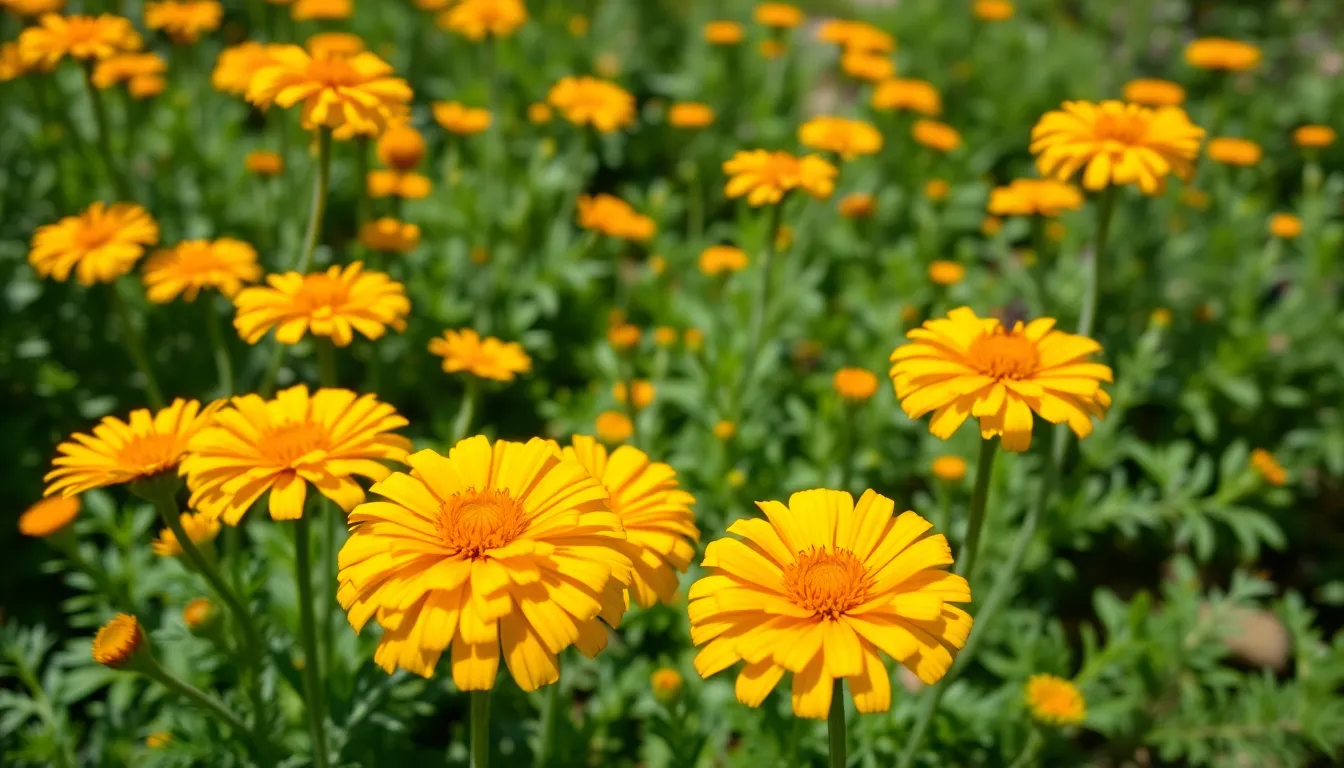
Calendulas bring vibrant yellow and orange hues to our gardens while offering exceptional culinary and therapeutic value. These versatile flowers combine beauty with functionality, making them perfect additions to any edible flower garden.
Soil Preparation and Watering Needs
Drainage becomes crucial when we prepare soil for calendulas, as these flowers thrive in well-draining conditions. We should ensure our planting area receives full sun to partial shade exposure for optimal growth. Soil temperatures between 65°F and 75°F (18°C to 24°C) create the ideal environment for calendula development.
Regular watering maintains healthy calendula plants, but we must avoid creating overly moist conditions. Excess moisture leads to root rot, which can destroy our entire calendula crop. We recommend checking soil moisture levels before each watering session to prevent waterlogged conditions.
Medicinal Properties and Culinary Applications
Anti-inflammatory benefits make calendulas valuable additions to our natural medicine cabinet. These golden blooms contain antimicrobial compounds that support healing and wellness. We can harness these therapeutic properties through various preparation methods.
Culinary versatility allows us to incorporate calendula petals into soups, salads, and garnishes throughout the growing season. Fresh petals add color and subtle flavor to our dishes. We can also dry the petals for brewing herbal teas or infuse them in oils for skincare applications.
Pest Management and Disease Prevention
Aphids and whiteflies commonly target calendula plants, requiring proactive management strategies. We can apply neem oil treatments to control these pests naturally. Introducing beneficial insects like ladybugs provides ongoing pest control without harmful chemicals.
Good air circulation prevents disease development in our calendula plantings. We should space plants appropriately and avoid overwatering to minimize disease risks. Regular plant inspections help us identify early signs of pest infestations or disease symptoms before they spread throughout our garden.
Lavender: Aromatic Purple Perfection

We’ll now explore one of the most beloved and versatile edible flowers that brings both fragrance and flavor to our culinary adventures.
Variety Selection for Culinary Use
English lavender (Lavandula angustifolia) stands out as our top choice for cooking applications. This variety offers a sweeter and more delicate flavor profile compared to other lavender types, making it perfect for culinary endeavors. French lavender and Spanish lavender tend to have stronger, more camphor-like tastes that can overwhelm dishes.
Culinary lavender varieties produce the most aromatic flowers during their peak blooming season. We recommend selecting plants specifically labeled as “culinary grade” to ensure they haven’t been treated with chemicals. Popular cultivars like ‘Munstead’ and ‘Hidcote’ provide excellent flavor intensity while maintaining the gentle taste profile we desire in our cooking.
Timing our variety selection affects the overall flavor concentration in our harvested flowers. Young plants typically produce more tender blooms with milder flavors, while established plants develop more intense aromatic compounds over time.
Pruning Techniques for Maximum Bloom
Regular pruning after blooming encourages new growth and promotes more abundant flower production. We should cut back the stems to about half their height immediately after the flowering period ends. This practice maintains the plant’s shape and stimulates fresh growth for the next blooming cycle.
Strategic pruning timing maximizes our lavender’s flowering potential throughout the growing season. We perform the main pruning session in late summer or early fall, removing spent flower spikes and about one third of the plant’s overall height. Light pruning in early spring helps remove any winter damage and shapes the plant.
Deadheading spent flowers extends our blooming period significantly. We regularly remove faded flower spikes by cutting just above the next set of leaves, which redirects the plant’s energy into producing new blooms rather than setting seeds.
Drying and Preserving Methods
Hanging lavender flowers in small bunches creates the most effective drying method for culinary use. We tie stems together with rubber bands and hang them upside down in a cool, dry place with good air circulation. This traditional approach preserves both color and essential oils within the flowers.
Freezing fresh lavender provides an alternative preservation technique that maintains flavor intensity. We can freeze whole flower spikes in sealed containers or create lavender ice cubes by freezing individual flowers in water. These frozen flowers work excellently in beverages and desserts.
Creating lavender syrup offers another preservation method that concentrates the floral essence. We simmer fresh or dried lavender flowers with sugar and water to create a versatile syrup that enhances baked goods, cocktails, and desserts while extending the flower’s usable life significantly.
Borage: The Cucumber-Flavored Star Flowers
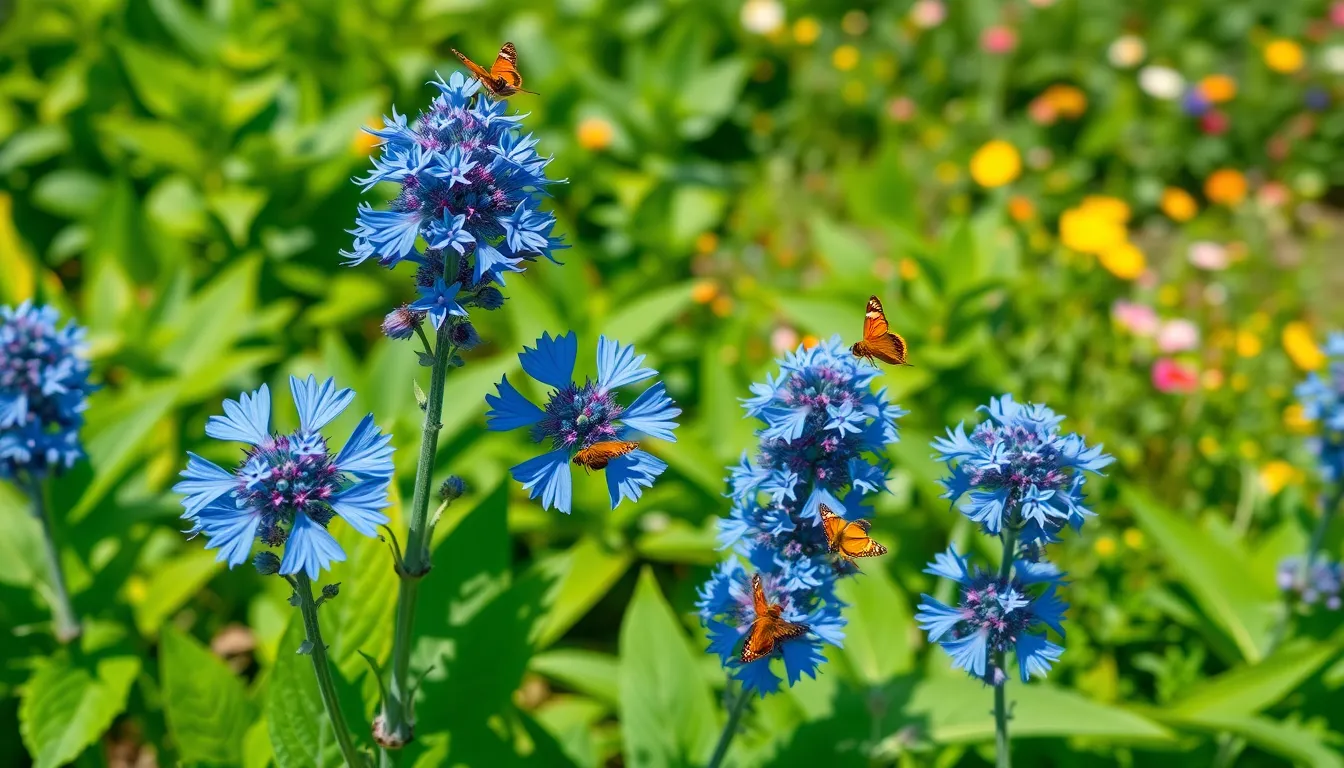
Borage (Borago officinalis) stands out among edible flowers with its distinctive star-shaped, vivid blue blooms that offer a refreshing cucumber-like flavor. Both the young leaves and striking blue flowers are completely edible, making this annual herb a versatile addition to our culinary garden.
Seed Starting and Transplanting Tips
Direct sowing works best for borage since this robust annual prefers to establish itself naturally in the garden. We recommend planting borage seeds directly outdoors in moist, well-drained soil after the danger of frost has passed, spacing plants 12–18 inches apart for optimal growth.
Starting seeds indoors offers an alternative approach if you want to get a head start on the growing season. Sow borage seeds 4–6 weeks before the last frost, then transplant seedlings outdoors when soil temperatures have warmed sufficiently.
Choosing a sunny location ensures the best flower production and overall plant health. Borage demonstrates remarkable self-seeding capabilities, so you’ll likely find volunteer plants appearing in subsequent years with minimal effort on your part.
Companion Planting Benefits
Attracting beneficial pollinators like bees and butterflies makes borage an invaluable companion plant in vegetable gardens. These visiting pollinators enhance overall garden productivity by improving pollination rates for surrounding crops.
Deterring certain garden pests naturally positions borage as a protective neighbor for crops like strawberries, squash, and tomatoes. The plant’s presence creates a more balanced network that supports beneficial insects while discouraging harmful ones.
Accessing deep soil nutrients through its taproot system allows borage to bring minerals and nutrients from the subsoil to benefit surrounding plants. This natural soil improvement makes borage particularly valuable in companion planting schemes.
Traditional Uses in Mediterranean Cuisine
Adding borage flowers and young leaves to salads and soups brings a crisp, cucumber flavor that Mediterranean cooks have treasured for generations. The refreshing taste complements other Mediterranean ingredients while adding visual appeal to traditional dishes.
Decorating beverages and foods with borage flowers creates stunning presentations in herbal teas and summer drinks. Chefs often use these vivid blue star-shaped flowers as eye-catching garnishes that also contribute their unique cucumber-like taste.
Creating tinctures and infusions from borage has historical roots in Mediterranean wellness practices, though modern culinary applications focus primarily on the mild, refreshing flavor the flowers and leaves provide to various dishes.
Roses: Classic Elegance for Your Plate
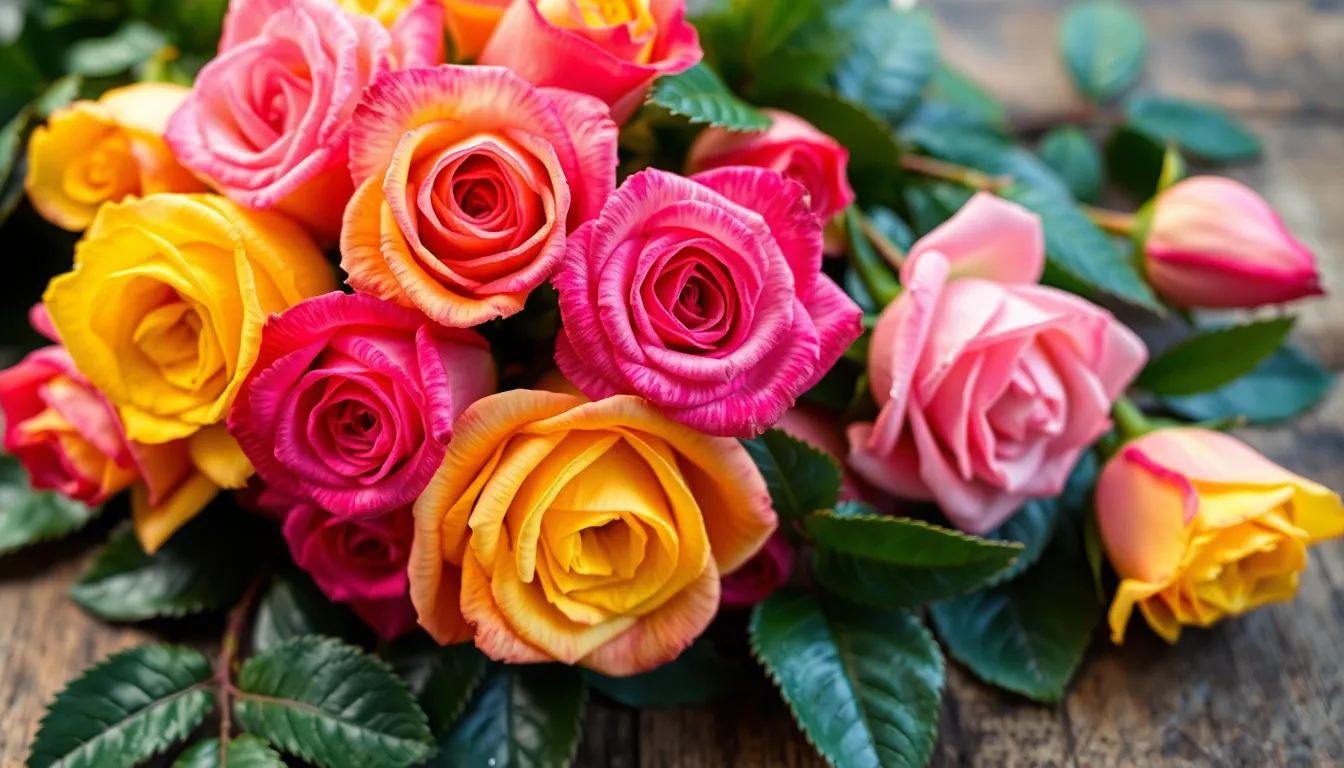
Roses bring timeless beauty and sophisticated flavor to our culinary adventures. These beloved flowers transform ordinary dishes into extraordinary gourmet experiences with their delicate fragrance and subtle taste.
Choosing the Right Rose Varieties
Damask roses offer the most intense flavor and fragrance for culinary use. We recommend these heirloom varieties for their exceptional taste and aromatic qualities that enhance both sweet and savory dishes. Hybrid Tea roses provide consistent blooms throughout the growing season with excellent flavor profiles. Their large, full blooms make them perfect for extracting petals and creating stunning garnishes.
Fragrant varieties should be our top priority when selecting roses for the kitchen. Modern hybrid roses often sacrifice scent for appearance, so we need to choose specifically bred culinary varieties. Pesticide free cultivation remains essential since we’ll be consuming these flowers directly.
Heritage roses like Rosa damascena and Rosa gallica deliver superior flavor compared to ornamental varieties. These time tested cultivars have been used in cooking for centuries and offer the authentic rose taste we’re seeking.
Organic Growing Methods and Fertilization
High quality planting mix creates the foundation for healthy, flavorful rose production. We should incorporate well composted organic matter to improve soil structure and provide essential nutrients naturally. Organic fertilizers like fish emulsion and bone meal feed our roses without introducing harmful chemicals into flowers we’ll consume.
Mulching around rose bushes conserves moisture and suppresses weeds while adding organic matter as it decomposes. We can use straw, wood chips, or shredded leaves to maintain consistent soil temperature and reduce maintenance needs.
Companion planting with herbs like lavender and thyme naturally deters pests while improving the garden’s overall health. These aromatic plants create a beneficial network that supports our roses without chemical interventions.
Regular watering at soil level prevents fungal diseases while ensuring consistent moisture for optimal bloom production. We should avoid overhead watering that can encourage black spot and other common rose ailments.
Making Rose Water and Culinary Preparations
Rose water creation begins with steeping fresh rose petals in boiling water for 10 to 15 minutes. We can strain the liquid and use it immediately in desserts, beverages, or Middle Eastern dishes that benefit from its delicate floral notes.
Culinary applications range from simple garnishes to complex flavor infusions in both sweet and savory preparations. Fresh rose petals work beautifully in salads, while dried petals can be ground into spice blends for lamb and poultry dishes.
Preservation methods include drying petals on screens in well ventilated areas or freezing whole blooms in ice cubes for elegant beverage presentations. We can also create rose flavored vinegars and oils by steeping petals in these liquids for several weeks.
Dessert preparations showcase roses’ natural affinity for sweet applications through rose flavored custards, ice creams, and traditional Turkish delight. The key lies in using just enough rose essence to perfume the dish without overwhelming other flavors.
Sunflowers: Bold Blooms with Nutty Flavors
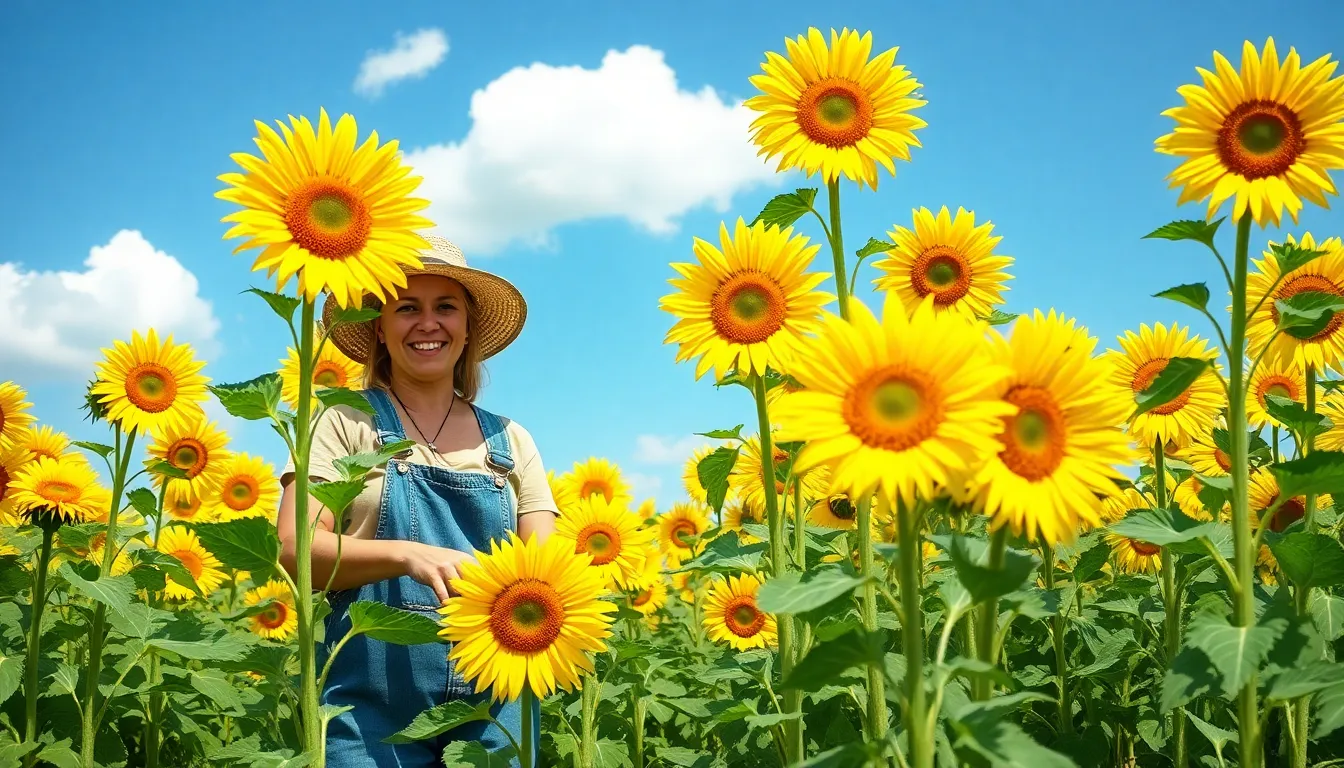
Sunflowers bring dramatic height and cheerful colors to our edible flower gardens while offering surprisingly delicious petals with a subtle nutty flavor. These iconic flowers provide both visual impact and culinary versatility that we can enjoy throughout the growing season.
Spacing Requirements and Support Systems
Proper spacing ensures healthy sunflower development and prevents overcrowding that can lead to disease issues. We recommend planting sunflowers 12 to 18 inches apart for smaller varieties and 2 to 3 feet apart for giant varieties that can reach heights of 10 feet or more.
Support systems become essential for taller sunflower varieties that face wind damage or toppling under their own weight. Installing sturdy stakes or bamboo poles at planting time prevents root disturbance later in the season. We secure the main stem loosely with soft ties, allowing for natural movement while providing adequate support.
Dwarf sunflower varieties like ‘Teddy Bear’ and ‘Little Becka’ require minimal support but benefit from closer spacing of 6 to 8 inches apart. These compact varieties work perfectly in container gardens and smaller spaces where we want to maximize our edible flower harvest.
Harvesting Petals at Peak Freshness
Morning harvest yields the best flavor when we collect sunflower petals after the dew has dried but before the heat of midday. We select flowers that have recently opened with vibrant, unwilted petals that feel firm to the touch.
Gentle removal preserves petal integrity and maintains the nutty flavor we seek for culinary applications. Using clean scissors or our fingers, we carefully pluck individual petals from the flower head, avoiding the bitter green sepals underneath. Fresh petals should be used within 24 hours for optimal taste and texture.
Storage methods extend usability when we can’t use the petals immediately after harvesting. We wrap fresh petals in damp paper towels and store them in the refrigerator for up to 3 days. Alternatively, we can freeze petals in ice cube trays with water for decorative drinks or dry them on screens for later use in teas.
Incorporating into Salads and Garnishes
Sunflower petals add vibrant color and a mild, nutty crunch to our salad creations. We sprinkle fresh petals over mixed greens, cucumber salads, and grain bowls where their sunny appearance brightens the presentation. The subtle flavor complements other mild edible flowers without overwhelming delicate ingredients.
Creative garnishing applications showcase sunflower petals in both sweet and savory dishes. We use whole petals to decorate cheese platters, scatter them over soups for visual appeal, or press them into butter for an elegant spread. These petals also work beautifully as natural confetti for special occasion dishes.
Preparation techniques enhance flavor when we lightly toast sunflower petals in a dry pan for 30 seconds to intensify their nutty taste. We can also incorporate fresh petals into homemade vinaigrettes or infuse them in olive oil for unique salad dressings that capture their essence.
Chive Blossoms: Onion-Flavored Purple Spheres
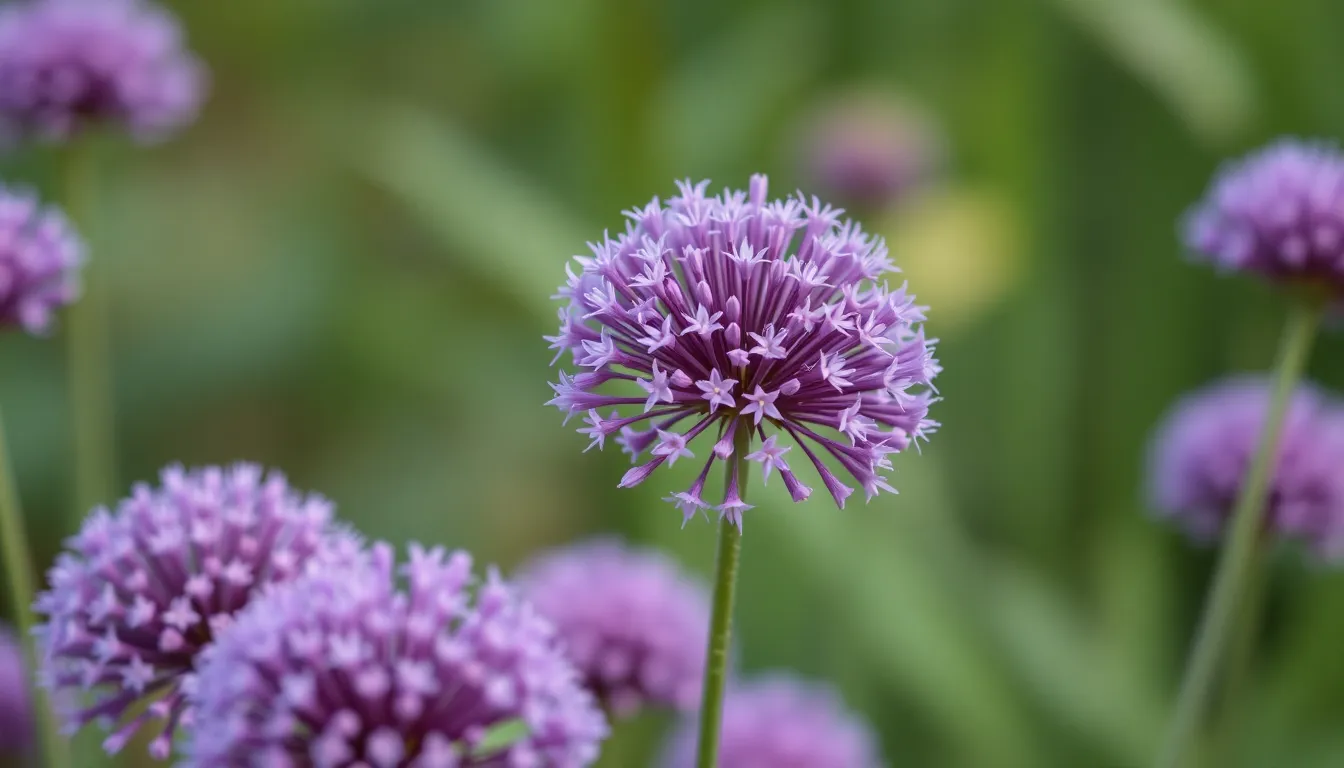
Chive blossoms stand out as one of our most reliable edible flowers, producing delicate purple globes that pack a mild onion punch. These perennial herbs bloom consistently throughout the growing season when we follow proper harvesting techniques.
Continuous Harvest Techniques
Regular harvesting encourages chive plants to produce more blooms and maintains their vigorous growth throughout the season. We recommend cutting flower stems at their base when the purple spheres are fully formed but still tight, typically in early morning when their flavor is most concentrated. Snipping every 2 to 3 weeks prevents the flowers from going to seed and redirects the plant’s energy into producing fresh growth.
Weekly inspections help us identify the optimal harvest time, as chive blossoms taste best before they begin to open and release their seeds. Cutting back spent flowers immediately after harvesting encourages a second flush of blooms within 3 to 4 weeks. Sharp, clean scissors prevent damage to the plant and reduce the risk of disease transmission between cuts.
Preventing Flowering for Leaf Production
Pinching flower buds as they emerge redirects the plant’s energy into producing tender, flavorful leaves instead of blooms. We can increase leaf production by 40% when we consistently remove flower buds before they develop into full blossoms. This technique works best during the plant’s active growing season from spring through early fall.
Strategic timing matters when we want to balance both leaf and flower production throughout the season. Allowing some plants to flower while preventing others from blooming gives us the best of both worlds. Cutting chive plants down to 2 inches above ground level after the first harvest stimulates fresh growth and delays flowering by 2 to 3 weeks.
Vinegar Infusions and Butter Preparations
Chive blossom vinegar captures the flowers’ delicate onion flavor and creates a beautiful purple tinted condiment that enhances salads and marinades. We infuse 1 cup of fresh blossoms in 2 cups of white wine vinegar for 2 to 3 weeks, straining out the flowers before storing in sterilized bottles. This preparation retains its flavor and color for up to 6 months when stored in a cool, dark location.
Compound butter made with chopped chive blossoms provides an elegant finishing touch for grilled meats and vegetables. Mixing 1/2 cup of fresh petals into 1 stick of softened butter creates a flavorful spread that freezes well for up to 3 months. Rolling the seasoned butter in parchment paper and chilling it for 2 hours makes slicing easier and creates attractive rounds for presentation.
Hibiscus: Tropical Tart and Vibrant
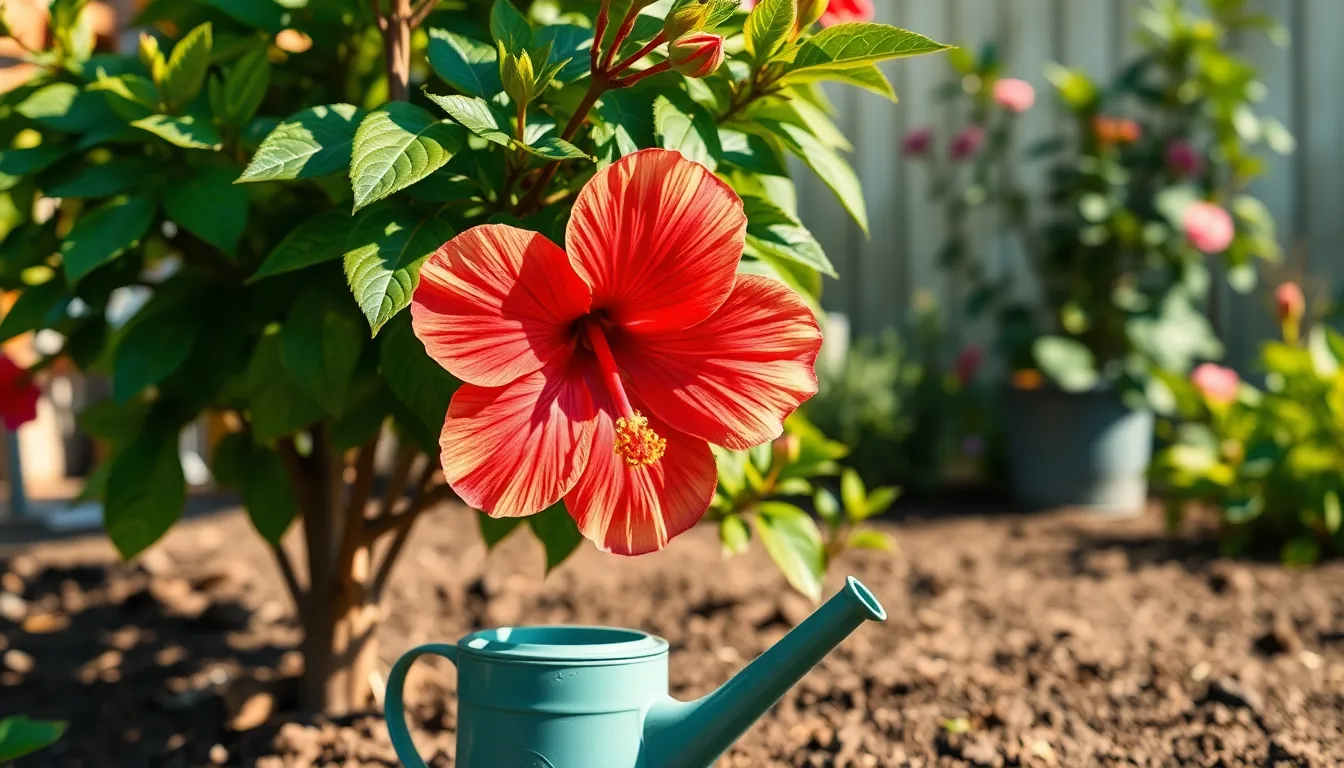
Hibiscus flowers deliver a vibrant splash of color alongside their distinctive tart flavor, making them exceptional choices for both gardens and culinary adventures. We’ve found these tropical beauties particularly popular for creating refreshing teas and colorful sorbets.
Container Growing for Colder Climates
Container gardening transforms hibiscus cultivation in colder regions into an achievable goal. We recommend starting with high-quality planting mix to establish the foundation for optimal growth, as this ensures proper drainage and nutrient availability.
Temperature control becomes crucial when growing these tropical flowers outside their natural climate zone. Hibiscus plants require consistent warmth above 60°F (15°C) to thrive, making container growing perfect for moving plants indoors during cold snaps.
Sunlight exposure should range from full sun to partial shade depending on your exact hibiscus variety. We’ve observed that most cultivars perform best with at least six hours of direct sunlight daily, though some varieties tolerate lighter conditions.
pH Requirements and Soil Conditions
Well draining soil forms the cornerstone of successful hibiscus cultivation, preventing root rot and other moisture related issues. We always test soil pH to ensure it falls between 6.0 and 6.5, as this range allows optimal nutrient uptake.
Nutrient rich growing medium promotes the vigorous growth and abundant flowering that makes hibiscus so rewarding. Organic compost and balanced fertilizers enhance soil quality, supporting both foliage development and flower production throughout the growing season.
Tea Making and Beverage Applications
Fresh hibiscus flowers create immediately usable tea ingredients, while dried flowers offer extended storage options for year round enjoyment. We steep dried hibiscus flowers in boiling water for approximately five minutes, then strain the liquid to achieve the perfect balance of tartness and flavor.
Beverage versatility makes hibiscus flowers valuable additions to various drink recipes beyond traditional tea preparations. Cold hibiscus infusions work beautifully in summer refreshers, while hot preparations provide warming winter beverages with their distinctive cranberry like taste profile.
Marigolds: Spicy Citrus Garden Guards
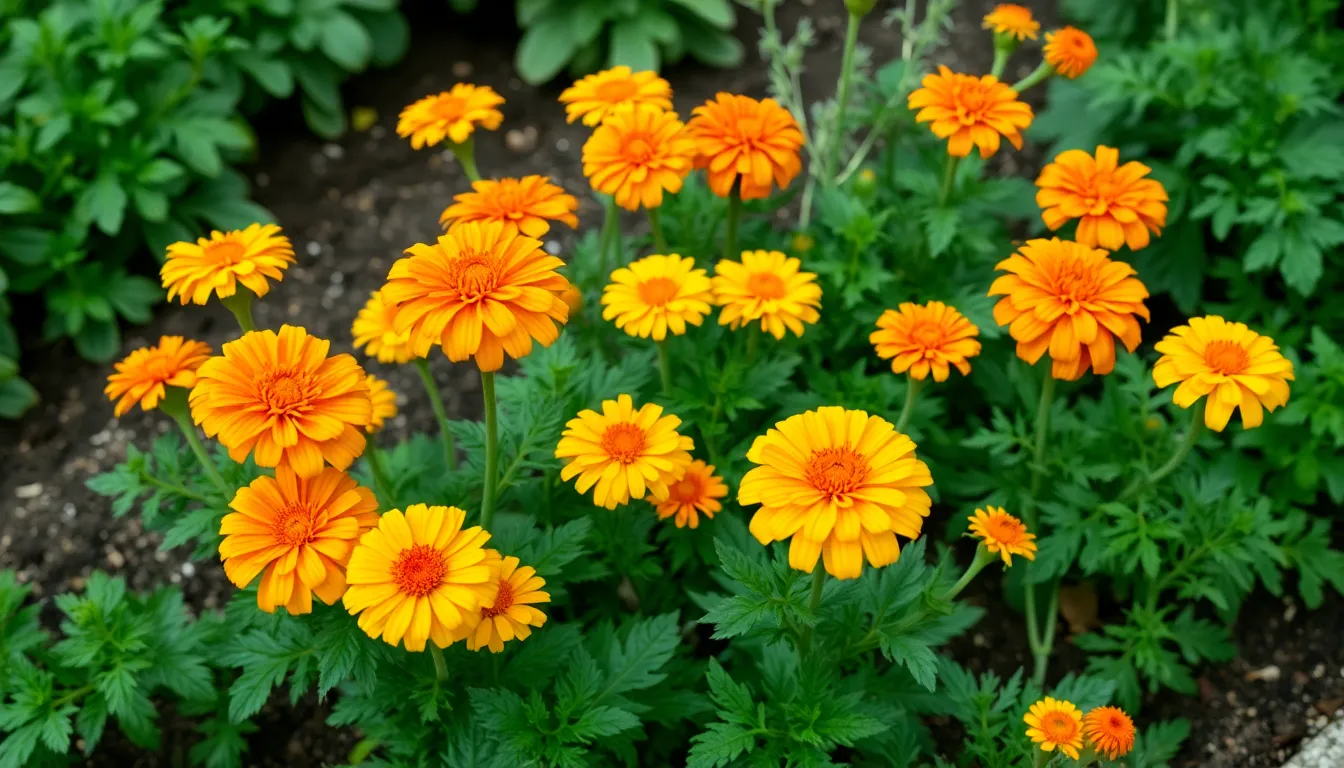
Marigolds bring both protection and flavor to our gardens with their vibrant blooms and natural pest-fighting abilities. These hardy flowers offer a unique citrusy taste that makes them perfect additions to our edible flower collection.
Pest-Repelling Properties and Companion Benefits
Marigolds serve as natural guardians in our gardens by repelling nematodes, whiteflies, and other harmful pests. Their strong scent acts as a deterrent, creating a protective barrier around vulnerable vegetables and herbs. We can strategically plant them throughout our garden beds to maximize their protective benefits.
Beneficial insects like bees and butterflies are actually attracted to marigolds, making them excellent companion plants. They create a balanced network by inviting helpful pollinators while keeping destructive pests at bay. Vegetables planted near marigolds often show improved health and reduced pest damage throughout the growing season.
Deadheading for Continuous Blooms
Regular deadheading keeps our marigolds producing fresh flowers throughout the growing season. We should remove spent blooms by pinching or cutting them off at the stem to encourage new growth. This simple maintenance task redirects the plant’s energy from seed production back into flower development.
Fresh flowers appear within days of deadheading, ensuring a continuous supply of edible blooms for our kitchen. The process takes just minutes each week but significantly extends the harvest period. Consistent deadheading can increase flower production by up to 50% compared to unmanaged plants.
Color Variations and Flavor Differences
Different marigold varieties offer distinct flavors and appearances for our culinary adventures. ‘Lemon Gem’ produces bright yellow flowers with an intense citrus scent and slightly bitter taste. ‘Tangerine Gem’ delivers vibrant orange blooms with similar citrusy notes but a more pronounced spicy finish.
‘Red Gem’ marigolds feature striking tomato-colored petals with gold centers, offering the most complex flavor profile of the three varieties. All varieties share that characteristic citrus quality with varying degrees of bitterness and spice. The intensity of flavor often correlates with the depth of color, with darker varieties typically providing stronger tastes.
Conclusion
Growing edible flowers transforms our gardens into living pantries that delight both the eye and palate. We’ve discovered that these versatile plants offer us an accessible way to elevate our cooking while creating stunning outdoor spaces.
Whether we’re new to gardening or seasoned growers we can confidently start with any of these varieties. From nasturtiums to marigolds each flower brings its own unique personality to our gardens and dishes.
The beauty of edible flowers lies in their dual purpose – they’re working double duty as both ornamental plants and gourmet ingredients. We’re not just growing flowers we’re cultivating experiences that connect us to our food in meaningful ways.
Start small with one or two varieties that appeal to you most. Before long you’ll find yourself experimenting with new flavors and discovering creative ways to incorporate these beautiful blooms into your daily meals.
Frequently Asked Questions
What are edible flowers and why should I grow them?
Edible flowers are blooms that can be safely consumed and used in cooking. They enhance both the visual appeal of your garden and the flavors of your dishes. Popular varieties include nasturtiums, violas, calendulas, and lavender. They’re easy to grow, even for beginners, and serve as gourmet ingredients that elevate home cooking while adding beautiful colors to your outdoor space.
Which edible flowers are best for beginners to grow?
Nasturtiums, calendulas, and marigolds are excellent choices for beginners. These flowers are hardy, require minimal care, and thrive in various growing conditions. Nasturtiums grow well in poor soil, calendulas are drought-tolerant once established, and marigolds naturally repel pests. All three produce abundant blooms and have distinctive flavors perfect for culinary experimentation.
How do I properly harvest and store edible flowers?
Harvest flowers in the morning after dew has dried but before the heat of the day. Pick blooms that are fully open and fresh-looking. Gently rinse and pat dry before use. Store fresh flowers in the refrigerator for 2-3 days in a sealed container with damp paper towels. For longer storage, freeze petals in ice cubes or dry them for teas and seasonings.
What growing conditions do most edible flowers prefer?
Most edible flowers thrive in well-draining soil with good air circulation and adequate sunlight (6-8 hours daily). While some like nasturtiums prefer poor to moderately fertile soil, others like violas need humus-rich, moist conditions. Generally, they require moderate watering – enough to keep soil moist but not waterlogged, as this can cause root rot.
Are all flower varieties safe to eat?
No, not all flowers are edible. Only grow and consume flowers specifically labeled as edible varieties. Avoid flowers treated with pesticides or grown near roadsides. Safe options include nasturtiums, violas, pansies, calendulas, lavender, borage, roses, sunflowers, chive blossoms, hibiscus, and certain marigolds. Always verify the specific variety is culinary-grade before consumption.
How can I use edible flowers in cooking?
Edible flowers can garnish salads, soups, and desserts, or be incorporated into beverages, vinegars, and compound butters. Nasturtiums add peppery flavor to sandwiches, violas sweeten desserts, calendula petals enhance soups, and lavender infuses teas and syrups. Rose petals make elegant garnishes, while hibiscus creates colorful teas. Start with small amounts to gauge flavor intensity.
Can I grow edible flowers in containers?
Yes, most edible flowers adapt well to container gardening. Use high-quality potting mix with good drainage and ensure containers have drainage holes. Smaller varieties like violas, chives, and compact marigolds work best in pots. Larger flowers like sunflowers need bigger containers. Container plants may require more frequent watering and feeding than ground-planted flowers.
What are the health benefits of eating edible flowers?
Many edible flowers offer nutritional benefits. Violas and pansies contain vitamins and antioxidants, calendulas have anti-inflammatory properties, and hibiscus is rich in vitamin C. Nasturtiums provide vitamin C and have antimicrobial qualities. However, flowers should complement a balanced diet rather than serve as primary nutrition sources. Always consume in moderation and verify safety for your specific health conditions.

